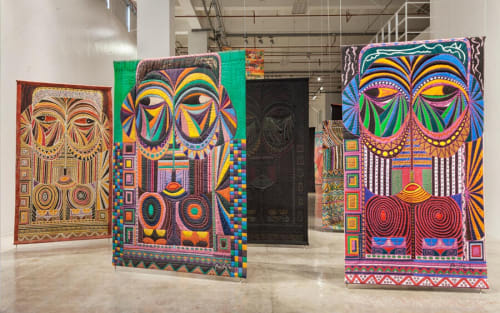I had to resist the urge, walking through Pacita Abad’s retrospective at Walker Art Center, to wrap myself in one of the artist’s colourful, hand-embroidered, canvas and fabric trapunto works. I wanted to be engulfed in their puffy, shimmering surfaces – at once maps, bodies and repositories. Foothill Cabin (1977), one of Abad’s earliest paintings, seems to echo this sentiment: the central figure – the artist’s husband – lies in bed, almost subsumed by an enormous patchwork quilt. Hovering above him are a series of yellow squares depicting lively figures inspired by Indigenous American art, while a swath of phulkari (Punjabi embroidery) stretches across the canvas like a textile sky.
Born in the Philippines in 1946, Abad lived a politically inflected life: photographs in the exhibition catalogue depict her participating in student protests in Manila during the 1960s and San Francisco’s countercultural movement of the 1970s. The central galleries house a broad selection of her social-realist paintings, including the four-and-a-half metre ‘portable mural’ Flight to Freedom (1980), whose matter-of-fact depiction of Cambodian refugees verges on National Geographic photojournalism. Though admirable, these works left me with the sense that the most interesting aspects of the artist’s interaction had occurred off canvas.
Curators Victoria Sung and Matthew Villar Miranda offer a elegant and precise presentation. But I found myself yearning for more of Abad’s maximalism: more trapuntos, with their virtuosic hand-stitched backs, shown in the round; more of her numerous fabric scrapbooks, teasingly displayed in vitrines at the edges of the exhibition, that hint at the spillage – a bench covered in Batik fabric; a dress continuously embellished with beads – so integral to her practice.
For it is the material politics of Abad’s work – accumulated from cultures across dozens of countries on six continents – that stuck with me. Works like 100 Years of Freedom: From Batanes to Jolo (1998) implement both Chinese and Spanish silks as well as Filipino cloth. They seem to image a globe in which borders were traversed as easily as her stitching. Abad’s travel was enabled by her husband’s work as a World Bank economist, but her itinerancy was balanced by her earnest immersion with local traditions and craft.
Ultimately, I found the works in which social critique is embedded in abstract gestures the most affecting. White Heightens the Awareness of the Senses (1998), for instance, features a central panel of primarily white squares brushed over with various colours, and those seemingly spontaneous brushstrokes are stitched back over in correspondingly hued thread – as if to affirm an intuitive thought as an action. It perhaps serves as an Asian diasporic rejoinder to Zora Neale Hurston’s line from her essay ‘How It Feels to Be Colored Me’ (1928): ‘I feel most coloured when I am thrown against a sharp white background.’
Abad’s later abstract works thrum with all the urgency of her realist paintings. Liquid Experience (1985) resembles a throbbing hide, with lava-like stains and bubbles. A trio of works in the ‘Abstract Emotions’ series (1984–2004) seems to realize the vision foreshadowed in Foothill Cabin: the world as pattern. Natural forces reflect emotional states: the agitation of a field full of flowers and pollinating bees; the sheer anticipation of a lily pad-filled pond as a rainstorm blows leaves off the willows; the velvet satisfaction of a rainy day. Abuzz with movement and light, these works don’t depict the exteriorized actions of social justice, but the searching soul that engines a life in pursuit of such equity.
—Simon Wu


